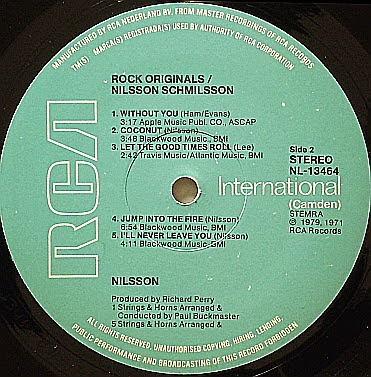In 1968, RCA Records made some radical changes to the then 70 year old record label/electronics manufacturer.
His Master's Voice, the iconic dog and gramophone image that appeared on
every RCA record and phonograph since 1900 was retired. In it's place
were the letters "RCA" in modern block lettering.
This outraged many collectors. Nipper was being replaced by an ugly bland orange label! How could RCA do this?
Next to the even bigger howl from music fans when RCA's infamous
Dynaflex vinyl was unveiled in 1971 (a super thin lightweight vinyl record which RCA claimed to be "the record of tomorrow"), RCA was constantly criticized for their corporate-heavy cheapness and questionable product.
To me, Dynaflex had it's good and bad. It WAS quieter. Even after 40 years, many of my old Dynaflex albums still have very little surface noise. But sonically, it was also quieter too, so you had to turn up the volume. And the ugly by-product of that; Because it was so thin, it tended to pick up any rumble from older turntable motors more acutely. Many automatic record changers some people used often dropped two Dynaflex records if they were played on them
But I consider this period to be RCA's most unique. RCA had established a series of sub-labels, all with different colours. I want to create a rainbow mosaic of all of them because they simply look cool when you put them all together.
Here's a small sample of these '70s colour labels from the US and from around the world.
The US:
 |
| Beginning in 1968, this label replaced the iconic black "Nipper" label. This was used for RCA's main rock/pop and country line |
|
|
 |
| Silver: To my knowledge, this metallic silver label was only used for this album. |
 |
| RCA Red Seal was their Classical/Opera label |
|
 |
| RCA Camden was used mostly for non-rock back catalog releases. It was ended in 1974 when RCA briefly transferred it's Camden line for distribution through Pickwick Records briefly until 1977. |
 |
| RCA Victrola was used for back catalog classical and opera reissues |
|
 |
| RCA Pure Gold was another reissue label for special low budget compilations |
|
 |
| RCA Quardradisc was used for special Quadraphonic albums |
|
 |
| RCA Educational was used for schools and music education. It's actually one of the harder to find labels of this era |
|
 |
| RCA Special Products was used for TV-offer albums and special releases |
 |
| White RCA Promo labels were used for radio stations |
 |
| Tan RCA Victor labels were used initially for their Special Products line, but in 1975-76 they were a "transitional" label they used before returning to a modernized black label with Nipper. Which they would use until 1988. |
|
|
From Around The World:
 |
| RCA Lineatre was used in Europe for special releases |
|
 |
| RCA Lineatres: From Portugal |
|
 |
| RCA Vik labels have been seen from many countries around the world, but none from the US. I've usually seen these labels on Mexican and Australian releases |
 |
| RCA Italiana: Label for the Italian market. Mostly of Italian artists with a few international stars |
 |
| This was a single label used for international releases in some countries |
 |
| RCA Australia: For Australian recording artists |
 |
| RCA Arc: Another Italian subsidiary |
 |
| RCA International: European imprint, similar to Camden |
 |
| German Black label |
 |
| British RCA Gold Seal |
I've seen other colours, including purple, maroon and dark brown (from Asia), but I can't find any either in my own collection or online to add here. But here's one more
I used to be curious about the Musicor's '70s label almost creepy similarity to the RCA label of the time. It reminded me of another little copycat label
But as it turned out, RCA DID manufacture Musicor during the '70s until 1977......

































